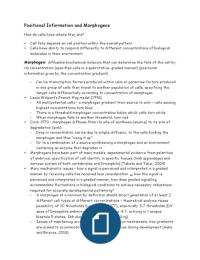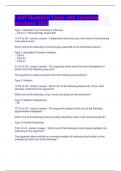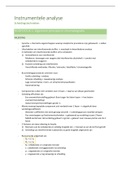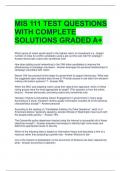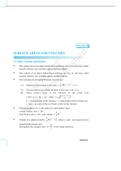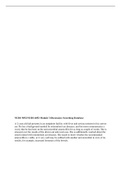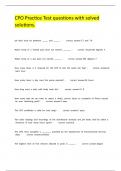CHEMISTRY PRACTICAL LABORATORY REPORT
Osman Yousuf – LPN 006
LEARNER NAME: Osman Yousuf
Group: A – O Church, R Brett, E Hodnett, I Firth
Date: 25/04/2023 Experiment Number: 006
Title: Determination of the Cooling Curve of Lauric and Stearic Acid
Criteria covered by this report: Unit 2 - P3, P4, M2 D2
Introduction
Lauric acid is a saturated fatty acid that is medium-chained, composed of 12 carbon
atoms. It is found as is found in coconut oil and palm kernel oil. This acid can be
used as medicine, or for soap and cosmetic productions.
Stearic acid is also a saturated fatty acid that is long-chained, composed of 18
carbon atoms. It is found as a great component of shea butter and cocoa butter.
Both Lauric and Stearic acid, when in the form of a white, crystalline solid, the
particles are in regular arrangement, that repeats and are in a three-dimensional
pattern. They have very low and limited kinetic energy, therefore they vibrate. When
these solids are heated, the temperature rises, resulting in an increase of kinetic
energy. Eventually, at specific temperatures depending on the compound, the
molecules overcome the intermolecular forces which attracts them together, this is
called the melting point and the state of the acids change from solid to a liquid.
Figure 1 - Skeletal Formula of Lauric Acid
Lauric acid have Van der Waals intermolecular forces present. The dipole-dipole
force exists due to the polar carboxyl group attached to the end of the molecule. The
carbonyl group (C=O) accepts a proton (hydrogen) and the hydroxyl group (OH)
donates hydrogens, therefore they also undergo hydrogen bonding. The dispersion
forces exist due to the non-polar carbon to hydrogen, and carbon to carbon bonds.
, Osman Yousuf – LPN 006
Figure 2 - Skeletal Formula of Stearic Acid
Stearic acid also has Van der Waals intermolecular forces present. The dipole-dipole
forces exist due to the polar nature of the carboxyl group. It also participates in
hydrogen bonding as of the high electronegativity in oxygen and the large difference
in compared to hydrogen of the carboxyl group. Dispersion forces exist due to the
non-polar carbon to hydrogen, and the carbon-to-carbon bonds.
When a liquid cools, it will eventually cool down to a specific temperature called the
freezing point. This is the reversal of the melting point process. The liquids will
resume the original form back to a solid.
The aim of this experiment is to study the effects upon cooling pure substance
through a phase change. Using this experimental data, the cooling curves can be
constructed, which will result in determining the freezing and melting point
temperatures of both acids.
Method
The method followed was that described in LPN 006.
Health and Safety
A risk assessment for the experiment was carried out prior to the start of the
practical. The following precautions were highlighted:
Lauric acid is corrosive and damaging to the environment, it must not be poured
down sinks as it is toxic to aquatic life with long-lasting effects (H401). Lauric acid
can cause serious eye damage (H318). Lauric acid can cause irritation to skin
(H315) and must not be ingested or inhaled.
Stearic acid must not be inhaled or ingested, and to be kept away from eyes as it
can cause irritation. Stearic acid may form fine combustible dust concentrations in
the air. The risk of explosive mixtures forming in air is low. As this dust can
accumulate in the air, it may cause irritation to the respiratory tract and skin upon
contact (H315)
PPE enforced, to include goggles as eye protection from droplets, particles, and
general contact with the acids. Lab coats and gloves to protect the skin from
spillages, and contact with the skin which can cause irritation.
, Osman Yousuf – LPN 006
Glassware and equipment were checked for leaks or cracks and other forms of
damage. Glassware and equipment must not exceed one’s height.
Utilisation of Bunsen burners to heat up water for Lauric and Stearic acid to be
dissolved in – use of thermal gloves to protect the skin from burns. The Bunsen
burner was on safety flame when not in use. A heatproof mat was placed underneath
the Bunsen burner and tripod to prevent and reduce thermal energy transfer to
nearby objects.
Using boiling hot water throughout – risk of burns that was prevented and minimised
with use of Lab coats and googles.
Results
Cooling of Lauric Acid via Digital Thermometer
Time (s) Temperature ( ̊ C ) Observations
0 50.0
20 46.3 Bubbles - Liquid
40 44.4 Partially transparent liquid
60 43.6 Areas of white forming on sides - liquid
80 42.5 White thickening – mainly liquid
100 41.6 Partially solid
120 40.5 Partially solid
140 40.5 Partially solid
160 39.3 Partially solid
180 38.7 Mainly solid – decreased in size - compact
200 38.0 Mainly solid – liquid at top
220 37.3 Mainly solid
240 36.7 Mainly solid
260 36.2 White solid
280 35.4 White solid – more compact
300 34.7 No changes
320 34.1 No changes
340 33.5 No changes
360 33.0 No changes
380 32.3 No changes
400 31.8 No changes
420 31.3 No changes
440 30.7 No changes
460 29.8 No changes
480 29.7 No changes
Osman Yousuf – LPN 006
LEARNER NAME: Osman Yousuf
Group: A – O Church, R Brett, E Hodnett, I Firth
Date: 25/04/2023 Experiment Number: 006
Title: Determination of the Cooling Curve of Lauric and Stearic Acid
Criteria covered by this report: Unit 2 - P3, P4, M2 D2
Introduction
Lauric acid is a saturated fatty acid that is medium-chained, composed of 12 carbon
atoms. It is found as is found in coconut oil and palm kernel oil. This acid can be
used as medicine, or for soap and cosmetic productions.
Stearic acid is also a saturated fatty acid that is long-chained, composed of 18
carbon atoms. It is found as a great component of shea butter and cocoa butter.
Both Lauric and Stearic acid, when in the form of a white, crystalline solid, the
particles are in regular arrangement, that repeats and are in a three-dimensional
pattern. They have very low and limited kinetic energy, therefore they vibrate. When
these solids are heated, the temperature rises, resulting in an increase of kinetic
energy. Eventually, at specific temperatures depending on the compound, the
molecules overcome the intermolecular forces which attracts them together, this is
called the melting point and the state of the acids change from solid to a liquid.
Figure 1 - Skeletal Formula of Lauric Acid
Lauric acid have Van der Waals intermolecular forces present. The dipole-dipole
force exists due to the polar carboxyl group attached to the end of the molecule. The
carbonyl group (C=O) accepts a proton (hydrogen) and the hydroxyl group (OH)
donates hydrogens, therefore they also undergo hydrogen bonding. The dispersion
forces exist due to the non-polar carbon to hydrogen, and carbon to carbon bonds.
, Osman Yousuf – LPN 006
Figure 2 - Skeletal Formula of Stearic Acid
Stearic acid also has Van der Waals intermolecular forces present. The dipole-dipole
forces exist due to the polar nature of the carboxyl group. It also participates in
hydrogen bonding as of the high electronegativity in oxygen and the large difference
in compared to hydrogen of the carboxyl group. Dispersion forces exist due to the
non-polar carbon to hydrogen, and the carbon-to-carbon bonds.
When a liquid cools, it will eventually cool down to a specific temperature called the
freezing point. This is the reversal of the melting point process. The liquids will
resume the original form back to a solid.
The aim of this experiment is to study the effects upon cooling pure substance
through a phase change. Using this experimental data, the cooling curves can be
constructed, which will result in determining the freezing and melting point
temperatures of both acids.
Method
The method followed was that described in LPN 006.
Health and Safety
A risk assessment for the experiment was carried out prior to the start of the
practical. The following precautions were highlighted:
Lauric acid is corrosive and damaging to the environment, it must not be poured
down sinks as it is toxic to aquatic life with long-lasting effects (H401). Lauric acid
can cause serious eye damage (H318). Lauric acid can cause irritation to skin
(H315) and must not be ingested or inhaled.
Stearic acid must not be inhaled or ingested, and to be kept away from eyes as it
can cause irritation. Stearic acid may form fine combustible dust concentrations in
the air. The risk of explosive mixtures forming in air is low. As this dust can
accumulate in the air, it may cause irritation to the respiratory tract and skin upon
contact (H315)
PPE enforced, to include goggles as eye protection from droplets, particles, and
general contact with the acids. Lab coats and gloves to protect the skin from
spillages, and contact with the skin which can cause irritation.
, Osman Yousuf – LPN 006
Glassware and equipment were checked for leaks or cracks and other forms of
damage. Glassware and equipment must not exceed one’s height.
Utilisation of Bunsen burners to heat up water for Lauric and Stearic acid to be
dissolved in – use of thermal gloves to protect the skin from burns. The Bunsen
burner was on safety flame when not in use. A heatproof mat was placed underneath
the Bunsen burner and tripod to prevent and reduce thermal energy transfer to
nearby objects.
Using boiling hot water throughout – risk of burns that was prevented and minimised
with use of Lab coats and googles.
Results
Cooling of Lauric Acid via Digital Thermometer
Time (s) Temperature ( ̊ C ) Observations
0 50.0
20 46.3 Bubbles - Liquid
40 44.4 Partially transparent liquid
60 43.6 Areas of white forming on sides - liquid
80 42.5 White thickening – mainly liquid
100 41.6 Partially solid
120 40.5 Partially solid
140 40.5 Partially solid
160 39.3 Partially solid
180 38.7 Mainly solid – decreased in size - compact
200 38.0 Mainly solid – liquid at top
220 37.3 Mainly solid
240 36.7 Mainly solid
260 36.2 White solid
280 35.4 White solid – more compact
300 34.7 No changes
320 34.1 No changes
340 33.5 No changes
360 33.0 No changes
380 32.3 No changes
400 31.8 No changes
420 31.3 No changes
440 30.7 No changes
460 29.8 No changes
480 29.7 No changes

